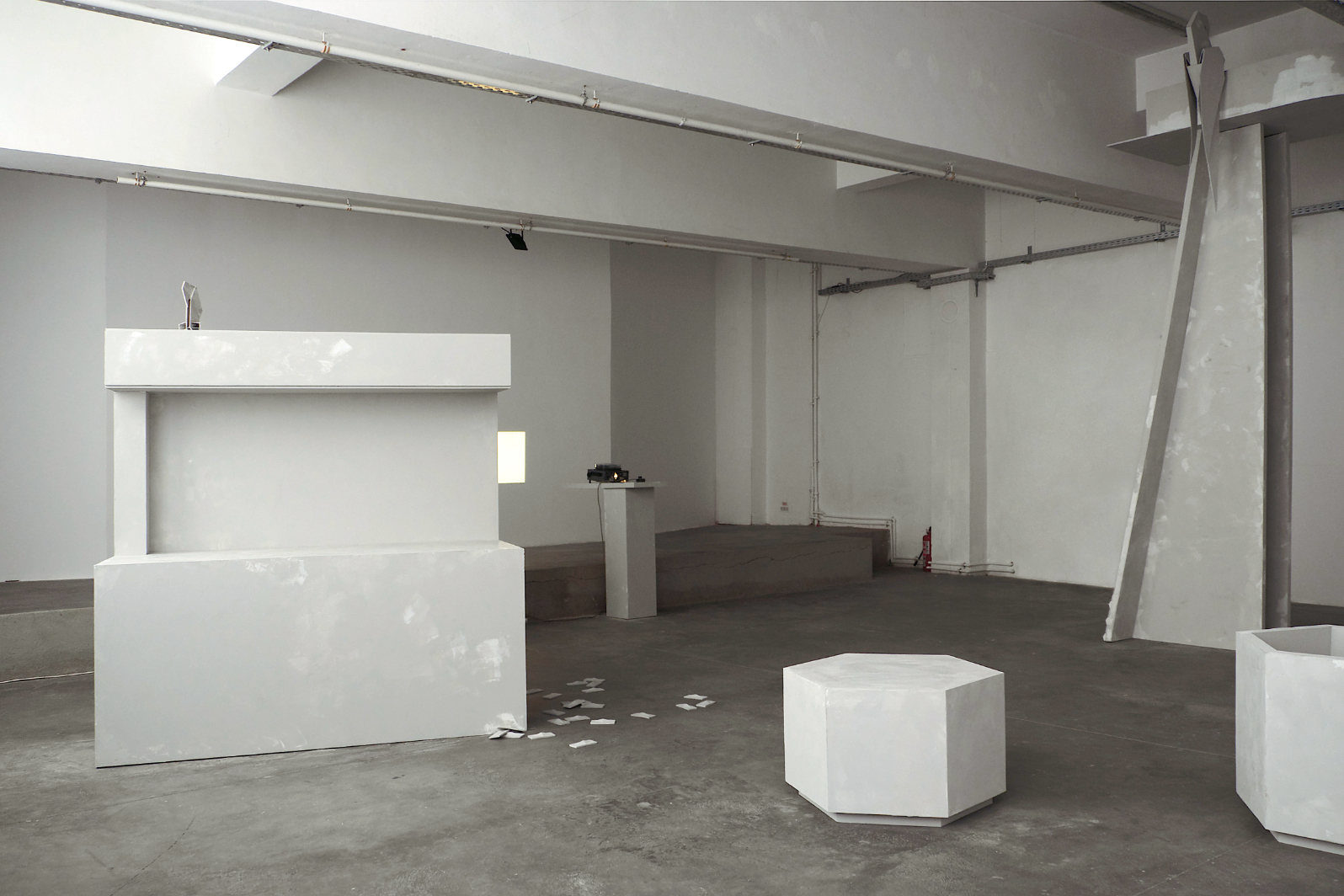







Kristin Wenzel
In In the the Future Future
September 10 - October 16, 2018
Ruins are inherently unstable. They are forms altered by time—physically, and always culturally. As art, they are only partially aesthetic, functioning as remnants of something else, shadows or echoes of a former existence that inform critique. The exhibition IN IN THE THE FUTURE FUTURE casts a shadow in reverse by engaging with ruins—not as a mere reference to the English grammatical tense “future-in-the-past” but in its literal sense. The landscape it explores, marked by abandonment and composed of the remnants of Modernist architecture, asserts a claim to timelessness. While apocalyptic scenarios are often projected into the future, a black-and-white photograph of a rainbow taken in 1986 pulls us into the past. This photo, adapted for a slide projector—a now obsolete mid-20th-century technology whose metallic clicking sound sharply punctuates the passage of time—is projected onto the wall. The carousel, perched on a stand that is as much aesthetic as functional, echoes elements of classical modernist architecture.
This landscape can be imagined as a time capsule, situated at the precise moment the photograph was taken by Kristin Wenzel’s father in former East Germany, where her family lived. This personal detail functions as an artifact—not in its literal sense but as an artistic position shaped by the necessity of self-mythologizing.
The photograph finds its counterpart in an immaterial image of a "rainbow," artificially created with light refracted through water, much like an experiment from a secondary-school science lab. In its broadest sense, the rainbow symbolizes a pure, childlike image. Children blow soap bubbles, fold paper, or construct objects from cardboard. Within the architectural framework of the exhibition, Wenzel incorporates three cardboard parrots to activate personal memories—an act that simultaneously prompts a re-evaluation of larger socio-political structures. The setting evokes the final image from J.G. Ballard’s 1975 novel High-Rise, in which birds become the last inhabitants of a Modernist apartment block. Similarly, these parrots serve as witnesses to a vanished world, yet their audience remains uncertain—no cultural object retains its meaning in the absence of new eyes to interpret it.
The exhibition also features a near 1:1 replica of a newsstand—a solitary booth that juxtaposes inside and outside. Wenzel actively searches for ideal locations, such as kiosks, abandoned shop windows, or temporary architectural structures, particularly from the 1970s in Bucharest or Berlin. These spaces, imbued with layered histories, become exhibition sites for her ephemeral interventions. Excavating our recent past, Wenzel uncovers the ideologies embedded in the ways institutions archive cultural heritage. Given that architecture is inherently political, Wenzel persistently seeks innovative ways to underscore its significance.
One such example is the view of a parrot perched atop a four-meter-tall tower, partially obstructed by the ceiling beam of ElectroPutere Gallery’s exhibition space. This purposeful framing reflects Wenzel’s critical engagement with Modernist architecture, highlighting its associations with top-down management, universalist aspirations, and the pursuit of purity in design. Scattered on the floor are small tiles, either affixed to sculptures or lying nearby. These tiles are replicas of ceramic pieces found on the streets of Craiova, produced before 1989 by a now-defunct factory. Wenzel’s recent projects often use obsolescence as fertile ground for examining the transition from state-run economies to global capitalism. Her 2018 Chapter 8 installation, initiated by CNTRM WRNHS Project Space, was a site-specific intervention in an abandoned guardhouse in former East Berlin, slated for demolition later that year. As a response, Wenzel constructed a 1:4 scale replica of the booth and placed it inside the original structure—a poignant act of homage.
Cultural heritage, often reduced to ruins, is treated as an awkward, forgotten presence—like a bachelor uncle at a family lunch, whose place at the table is uncertain. In Romania, collective memory still lingers under the weight of a self-imposed amnesia. Communism is frequently perceived in Eastern Europe as an interruption—a "delay" in the so-called "normal" trajectory of development. Once this intermission ended, it left behind little more than an appetite to "make up for lost time" by constructing a Western-style capitalism. Yet, there is a growing need to recover and critically reassess the disavowed ideals and artistic practices of that era. To historicize the period objectively, through the lens of its utopian ambitions, is essential—without succumbing to nostalgia or allowing such efforts to become obsolete.
Globally, dystopian visions continue to coexist with utopian hopes for more favorable futures. The proliferation of apocalyptic narratives in popular culture has spawned a well-worn refrain: it is easier to imagine the end of the world than the end of capitalism. Originating in the postmodern zeitgeist, this phrase often resurfaces without attribution. Yet resistance to contemporary malaise ebbs and flows with circumstances, offering fleeting moments of renewal—opportunities to re-engage with life’s real sorrows and possible joys. While dystopian narratives often depict grim futures for the marginalized, IN IN THE THE FUTURE FUTURE reframes the future through the lens of an event already past. One provocative hypothesis suggests that the end of the world has already occurred, leaving humanity to confront the wreckage and focus on reconstruction.
Curated by Mihaela Varzari
Kristin Wenzel attended the art academies in Münster and Düsseldorf, graduating in 2013 as a Meisterschülerin under Prof. Katharina Fritsch. Her recent solo exhibitions include Chapter 8 (2018) initiated by CNTRM, Berlin; Nothing (2017) at Sightfenster, Cologne; and Model for a Pavilion #2 (2017) in Bucharest. In 2018, she co-founded the artist initiative Template in Bucharest with Vlad Brăteanu, Alice Gancevici, and Remus Pușcariu.
Mihaela Varzari lives in London and is pursuing a PhD in the History of Art at the University of Kent, UK. She previously studied at Birkbeck College and Goldsmiths College between 2009 and 2015. An independent curator, she has collaborated with artists such as Liliana Basarab (RO), Ziad Antar (LB), and Heath Bunting (UK). Since 2008, she has published art criticism in Revista ARTA (Bucharest), thisistomorrow (London), and IDEA arts+society (Cluj), among others.